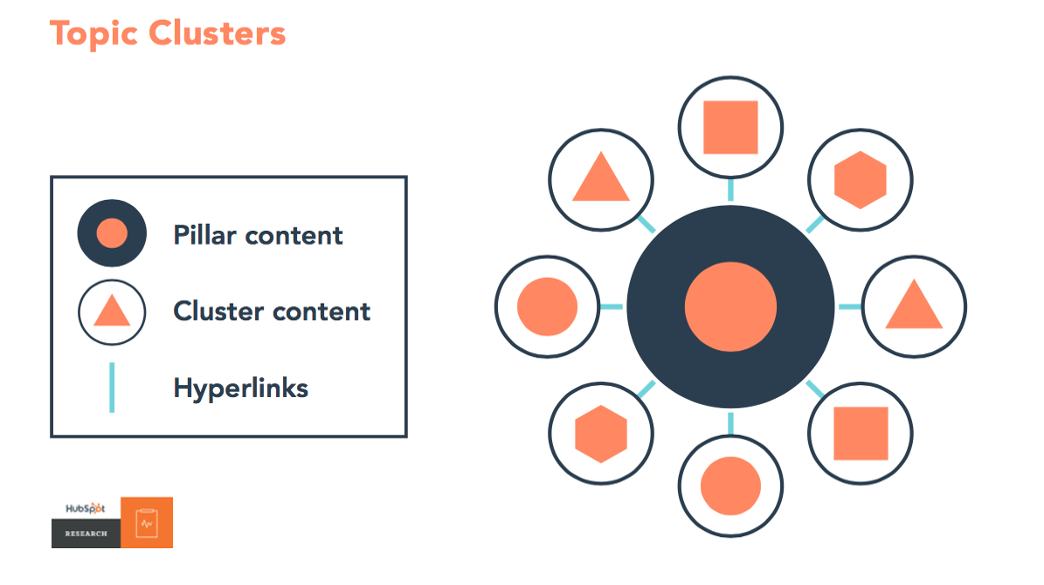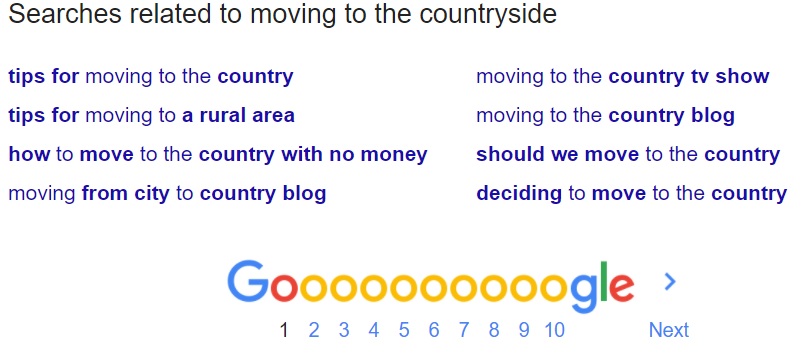Topic Clusters – What Are They and Why Do You Need them Anyway?

Topic clusters have been called “the future of SEO”. You may not have seen them too often yet, but that’s only because they haven’t quite reached the popularity of, say, e-books or white papers.
But they’re getting there.
Until then, this is your chance to take the Internet by storm and get a significant advantage over your competition.
Let’s take an in-depth look at topic clusters.
But first, let’s understand what makes them the new cool kids on the content marketing block.
SEO and User Intent
Gone are the days when searches sounded robotic. In the era of Alexa and Siri, search engines have gotten smarter and started to understand user intent.
Search is now conversational. For example, instead of searching for “Starbucks in Los Angeles” and then sifting through the addresses of all the Starbucks in the city, I can simply search for “Starbucks near me”.
Easier, faster, user-friendlier.
The rise of voice-assisted search has shed new light on user intent.
In copywriting and content writing, though, things continued to lag behind. SEO copywriters found it hard to get as conversational as users needed them to be and still get great rankings.
Keywords were the starting point for almost every content strategy in the past decade. And it was perfectly normal and understandable.
However, the times have changed.
We now understand user intent. And Google has shown us, time and again through the algorithm changes it made, that so do its bots.
So, writers and agencies offering copywriting services have adapted. At first, we used long-tail keywords to get conversational and capture highly qualified traffic.
Then, we started using LSI keywords to avoid keyword stuffing and have our pieces flow naturally. And to rank better, of course, because we knew that Google noticed.
Along with LSI keywords came the rise to glory of long form content. We ditched the traditional 500-word blog post and moved toward articles that could be as long as 4,000 words.
And it was good. We got results. We managed to get to the users that wanted even more, to the readers that wanted real in-depth content.
But it’s time for even more.
Enter topic clusters.
What Are Topic Clusters?
Topic clusters are the epitome of long-form content. In a nutshell, you think about a subject and then you write about everything related to it. Expect to get well over 10,000 words.
However, they are not exactly blog posts.
This amazing video from HubSpot provides an excellent explanation for topic clusters and why we need them.
Let me summarize it for you: topic clusters are a novel approach to SEO, one that focuses on topics instead of keywords. In return for your hard work in topic clusters, you get a better website architecture and you make it easier for Google (and your readers) to find and index related content.
Consequently, you will also rank better for keywords you may have not even dreamed of ranking for.
So is a topic cluster basically just a really long blog post?
Not really.
The Architecture of a Topic Cluster
A topic cluster has its own anatomy, which makes it very easy to navigate.
The pillar page acts as the main hub for the content. This is the “central node”, if you will, which comprises all the content.
The subtopics are the chapters of your cluster. Much like the chapters of a novel, they break down the content is smaller, easily digestible parts. The subtopics are related to each other, but can also function independently.
The hyperlinks connect every subtopic to the pillar page. They are the grid that holds everything together and that’s responsible for your gaining a lot of SEO traction.
Let’s look at an example to make it easier to understand. Say I’m thinking about leaving the noisy city behind and moving to the countryside. I want to create a topic cluster that could provide every possible information on the topic.
Moving to the Countryside
Pillar page. The above could be the title of my pillar page. I can write a short introduction to the topic (for example, why I decided it’s important for me), then move on to branch into subtopics.
My pillar page should also contain the links to all the subtopics I am going to cover. This will tell search engines that I have a really comprehensive, in-depth page on moving to the countryside. In turn, Google will rank my page higher.
Subtopics. Now I want to get really comprehensive with this and leave no stone untouched. I want to make sure that everyone who thinks about moving to the countryside can find all the information they need in this page.
I would cover topics like:
- Advantages of moving to the countryside
- Disadvantages of moving to the countryside
- Famous people who moved to the countryside
- How to choose the ideal location for your dream country house
- How to find the best countryside home within your budget
- How to decorate your new countryside home
- How to deal with harsh winters in the countryside
The list could go on and on, but you get the point.
The best thing about topic clusters is that you can add to them anytime and make them an even more powerful SEO resource. For instance, let’s say I made the big step and moved to the country side. I could add another subtopic on “How to make friends in the countryside when you’re new in town”.
Google itself can provide me with new ideas to make my topic cluster truly comprehensive. A simple query on my title can reveal what people actually search for. I can use this information to deliver exactly what people want to know.
“It’s a LOT of work! I’m better off writing 20 regular blog posts and covering all these subtopics.”
I know it may seem that way. But creating an amazing topic cluster doesn’t have to take your months or years. It won’t be short, but it won’t be painful either.
How to Create Topic Clusters Easily
OK, I’m going to be honest: if you want to create topic clusters from scratch, it will take months. At least one month. Our record for creating a topic cluster from scratch for a client was two weeks. But that involved a lot of awesome copywriters!
However, odds are you won’t have to do it from scratch. If your website or business aren’t brand new, then you must have already written some content or articles on the topic and subtopics.
What you have to do now is actually one of my favorite things: repurpose content. In other words, make it work for again, this time harder.
Here’s where to start:
-
Find the Perfect Pillar Page
One of your web pages or blog posts that already gest a fair amount of traffic is your ideal pillar page. Sift through your website and find pages that have the potential to be the pillars of your topic cluster.
If you can’t find such a blog or article, you can simply create a new one. Go for a broad core topic, one that you can easily split into multiple subtopics.
-
Research Subtopics
Think about the countryside example above and try to come up with subtopics that you can add to your pillar page. Aim to have at least five of them (I prefer seven, but five work, too).
Look through your previous blog posts. How many of them already fit in your topic cluster? You will be surprised to find out that quite a lot of your work is already done.
Sure, you may need to do some rewriting, but it won’t take too long.
Next, make sure you’re really covering your topic. Google searches are a good place to start, but I would also recommend checking BuzzSumo and Moz Explorer for new ideas and keywords.
As you check your blog for suitable subtopics for your first topic cluster, you will see that more ideas for new clusters will appear. If you have more than 100 blog posts published, forgetting about some of them is inevitable.
But as you set to create your first cluster, you will stumble upon other posts and pages that have a lot of unexplored potential.
-
Don’t Forget about Inbound Linking
Remember that all the subtopics need to link to your pillar page and that your pillar page has to link back to all of them. Your topic cluster has two main purposes:
- Making navigation easier (it’s easier to find information in topic clusters than it is to search on the blog)
- Boosting your page ranking
None of them can be accomplished without proper inbound linking. The more links in your pillar page, the better your chances of significantly boosting your page ranking.
Conclusion
HubSpot began experimenting with topic clusters in 2016. The results they had were overwhelmingly positive. The more interlinking they did, the better their position in SERPs and the more views they got.
In the meantime, a lot of other companies implemented this strategy. And I haven’t heard any complaints yet.
Bottom line: topic clusters work. But just like any other tactic, they need to be properly implemented in order to yield great results.
Feel like creating topic clusters on your own is overwhelming? We can help! We’ve done quite a few topic clusters for our clients and loved every moment of it (almost as much as our clients loved the results)!






6 Comentarii la “Topic Clusters – What Are They and Why Do You Need them Anyway?”
[…] pinnacle of long-form authority content, topic clusters can generate B2B leads […]
[…] guides and topic clusters. While harder to write and read, in-depth guides and topic clusters are ideal for truly exhausting […]
[…] an example: after creating a series of topic clusters for an SaaS client, they wanted to turn them into gated content so they can collect more email […]
[…] guides are great. And, much like topic clusters, they will help your rankings a […]
[…] Topic clusters are a great way to rank for these foundational keywords. […]
[…] both primary requirements above, you wind up with at the very least a loads topic or an impressive topic collection. Certain, a few of these articles may be fairly comparable per various other. However, this does […]